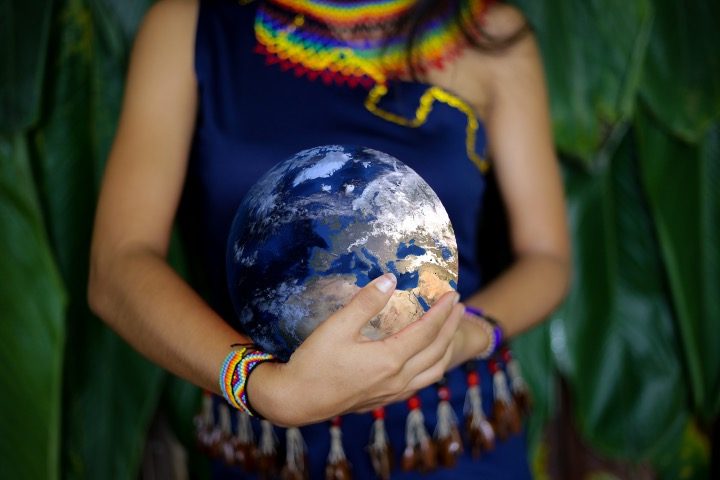
It took man millennia to advance from superstition to the scientific method.
Now it might take the atavistic Biden administration only a moment to regress.
Some may thus conclude with the revelation that the “Food and Drug Administration and Centers for Disease Control and Prevention could soon employ ‘Indigenous Knowledge’ in their research, a document obtained by the Washington Free Beacon shows,” the website reported Tuesday.
“‘Indigenous knowledge’ posits that native peoples possess hidden wisdom about the workings of the universe…,” and embracing such “is part of the agency’s ‘support’ for ‘equity, justice, and trust,’ the document states,” the Beacon further informs.
As an aside here, the White House official who led this indigenous-knowledge embrace, advisor Jane Lubchenco, is currently barred from publishing work in scientific journals due to ethics violations.
This said, it would be understandable if you believed this “indigenous knowledge” push concerned finding natural remedies, commentator Olivia Murray points out. In reality, however, she writes, the true motives appear “more sinister.”
As to this, the Biden administration announced in a late 2022 press release (as presented by Murray) that the White House
released new government-wide guidance and an accompanying implementation memorandum for Federal Agencies on recognizing and including Indigenous Knowledge in Federal research, policy, and decision making.
…
Indigenous Knowledge is a body of observations, oral and written knowledge, innovations, practices, and beliefs developed by Tribes and Indigenous Peoples through interaction and experience with the environment. The Biden-Harris Administration has formally recognized Indigenous Knowledge as one of the many important bodies of knowledge that contributes to the scientific, technical, social, and economic advancements of the United States….
“As the original stewards of the natural environment, Tribes and Indigenous communities have expertise critical to finding solutions to the climate crisis and protecting our nation’s ecosystems.”…
Ah, there it is: This is in part about the “climate crisis,” though “we can rationally infer that the Bidenites don’t want actual solutions … otherwise they wouldn’t be supporting all the endless policies that have proven to decimate the environment,” Murray states. So what kind of “wisdom” do they want? Is it, she wonders, the following climate-related “indigenous knowledge”?
“According to Aztec cosmology, the sun god Huitzilopochtli was waging a constant war against darkness, and if the darkness won, the world would end,” History.com informs. To “keep the sun moving across the sky and preserve their very lives, the Aztecs had to feed Huitzilopochtli with human hearts and blood.”
While a bit snarky, this relates to a deeper point: This “indigenous knowledge” obsession’s predicate is that American Indians lived in perfect harmony with their environment. As the White House also claims, “indigenous knowledge” promotes “environmental sustainability and the responsible stewardship of natural resources….” Sounds wonderful.
It’s also mythical.
Now, in accordance with Ralph Waldo Emerson’s observation, “Every man I meet is my master in some point, and in that I learn of him,” American Indian cultures are like all others in that they have something to offer. There’s also another commonality: Contrary to the comic-book version of history, Indians were real people with real flaws — environmental destruction among them.
For example, small Indian “agricultural settlements up and down the Delaware River Valley caused a 50-percent increase in sediment runoff into the Delaware River,” reported Smithsonian Insider in 2011 on new research. “This was done primarily by burn-clearing of as much as half of the forest-cover along the Delaware’s banks.”
Ironically, the Smithsonian Institution was partially responsible for the noble-savage myth-making in the first place, having published a 1991 book claiming, “Pre-Columbian America was still the First Eden … a world of barely perceptible human disturbance.” Live and learn, I guess.
But the Delaware River Indians weren’t outliers. “Among other things,” wrote the Mises Institute in 2007, Indians “engaged in slash-and-burn agriculture, destroyed forests and grasslands, and wiped out entire animal populations (on the assumption that animals felled in a hunt would be reanimated in even larger numbers).”
And Indians also used “controlled burns” (which sometimes raged out of control and wreaked havoc) to “divert game into small unburned areas in order to make it easier to hunt the animals,” the New York Post related in 2015.
“Other hunting methods included the ‘buffalo jump,’ where a man would drive an entire herd over a cliff,” the paper added, leading to “‘horrible waste and inefficient use of resources.’”
In conclusion, the Indians were very human: When “resources were scarce, Native Americans worked to conserve them,” the Post summed up. “When they weren’t, they didn’t.”
The reality is that the White House’s statement is woke babble. For instance, American Indians are not “the original stewards of the natural environment”; they are today modern people who, like the rest of us, enjoy Western civilization’s technological wonders.
Oh, the White House meant the Indians have ancestors who were those stewards?
So does everyone!
We all have ancestors who were “indigenous” (to somewhere) and the natural world’s “original stewards.” This status is meaningless.
Meaningful is that it is Western civilization — with its scientific method (among other things) — that provides the two prerequisites for sustaining a healthy environment along with large populations: freedom and prosperity (I explained this here).
In fact, since the feds also mention “indigenous” spirituality, note that if we’re going to point to a spiritual influence in conservation, it perhaps should be Western clergyman Francis of Assisi (relevant short video below).
In reality, when Western civilization reached the New World, the Indians were still living in the Stone Age and had not invented the wheel or a written language. We all have distant ancestors who were likewise primitive — and good luck finding anyone who yearns to return to that state.
As for the feds, they’re much like the young white guy in the comedic Malcolm in the Middle video below; they ought to heed the Indian reprimanding him, too.
Now, that’s some “indigenous” wisdom right there.



